|
Ed. Note:
Since he originally wrote this article,
Jeff has developed a Snake Stopper load for the .45 Colt cartridge
using the same method as for the .38 Snake Stopper. The .45 Colt
load uses 5 grains of W-W 231 powder and a .457 round ball. This
load exhibits excellent pattern density, and performs very well.
Boge Quinn
  
Ed. Note:
GunBlast.com reader Randy G. Evans was
inspired by Jeff's Snake Stopper article to do some snake load development
of his own, and he sent us his results. We are glad to see that some of
our readers are intrigued enough by what we do to expand on the idea!
Randy's findings are his alone, and have not been reproduced by
GunBlast.com, and GunBlast.com accepts no responsibility for them.
Following is Jeff's article, Rattlesnake Stopper", followed by Randy's article, "Snake Stopper II".
Boge Quinn
  
This Summer in Tennessee has been particularly dry and warm, and as a
result, we've seen what seems to be an unusual number of snakes...especially timber rattlers.
The theory that I have been told is that they are
having to move more to find water than in previous years. Whether that theory is
accurate or not I can't say. What I can personally attest to is the fact that my cousin,
who lives about two miles down the road, has been overrun this year with an
abundance of rattlesnakes, with the occasional copperhead thrown in for extra excitement.
One day while talking with my cousin Melvin, he
mentioned to me that the particular rattler that he had shot that morning had required
three shots of commercially loaded snake shot before deciding to cease hostilities and die.
Melvin had been having snake problems all summer. One of his squirrel dogs had almost died of
snakebite earlier this year. We decided that we needed something with more
killing power than was available off the shelf while still retaining a wider
pattern than could be obtained with just a single bullet.
After our conversation had ended, I went to
work on the project.
The problem of getting more shot into the case was solved by
doing away with the plastic tube as found on the factory loads. I decided to
use the .38 Special case so that it could be fired in either his .38 or his .357 magnum.
Eliminating the plastic shot tube left me with two
problems. First, a wad was needed to separate the powder from the shot. It had to be thin enough so as not to
take up too much of the already limited case capacity, and thick enough to seal the bore to
send the shot out of the barrel. I decided to use a heavy card material, about .030 thick. To
cut the card wads to exact internal case diameter. I sharpened the mouth of a
.38 case with a deburring tool and chucked the case in a drill to cut the wads from a sheet of
the cardboard. It worked great.
The other problem caused by eliminating the plastic shot
tube was how to seal the case mouth over the shot, so that it would not spill all over the
place. I tried hot glue, superglue, 38 caliber gas checks and another card wad. The final
and best solution was to seat a .375 pure lead round ball over the shot. It is easier to see
from the photos the seating depth than it is to explain the process, but the depth isn't critical
as long as the crimp holds it in place.
The final incarnation consisted of a Remington-Peters
case, loaded with 4.3 grains Winchester 231 powder. Over the powder I seated
the card wad with a 1/4" wooden dowel. Filling to within 3/16" of the case mouth with 70 grains
of number nine hard shot, I seated and roll crimped the .375 round ball.
As can be seen in the photo, the shell patterned about nine
inches at a distance of 10 feet, with the round ball well centered. At that distance,
even the card wad penetrated the plastic sign board used for patterning.
The result of this project was a real success, as it gave us a superior
shot load with the added benefit of a round ball in the middle.
It was within a week that cousin Melvin reported back on the
handful of cartridges that I had issued to him. He had run across another fat rattlesnake about four feet
long back on the farm. One shot, one dead rattler. Later in the week a wild
stray dog, possibly rabid, came to his house with what seemed to be ill intent, and was easily
dispatched with one quick shot.
As always, these loads work great and are safe in our
guns, but might not be safe in your particular firearm. Work up your reloads safely, as we
assume no responsibility for any loading data listed on this website. The powder and bullet companies
have pressure and safety equipment not available to us, and are far more knowledgeable about this stuff. It is wise to
heed their advice.
But then again, experimenting with a new project is always
interesting and usually fun.
Jeff Quinn
  
Snake Stopper II
By
Randy G. Evans
After reading Jeff Quinn’s great
article “Rattlesnake Stopper” I decided I had to give it a try.
Never one to be too hasty, I had to ponder a while on how I would
assemble his load. Sometimes
this thick head just can’t follow the instructions clearly spelled out
before it. Taking into
account what supplies I had on hand, I decided I would substitute Clays
for WW231, and would cut the cardboard wads out of some .050” 28 gauge
over powder wads that I had no use for and had been laying out in the
garage for quite some time. I sharpened the face of a 38 Special case and tried to chuck
it into my drill motor to cut the wads.
The case head was too wide to fit in my chuck, so out came a mallet
and a piece of plywood to hammer on.
After some considerable noise that seemed to irritate the wife, and
four bent cases later came a plastic baggy full of sized wads.
I settled on the 38 Special case since I had 500 or so on hand.
I had several shot sizes available in my reloading cache, so the
only thing left to find was a suitable round ball to cap the cases off.
I fully realize that Mr. Quinn’s loads have been perfectly safe
for him, but I just couldn’t stop thinking about the amount of swaging
that would take place pushing a .375 diameter projectile through my .357
barrel. [Ed. Note: When
the .375 round ball is seated, the excess lead is shaved by the die and
case, resulting in a nicely-finished, properly-sized ball somewhat
resembling a wadcutter in appearance, as can be seen in Jeff's photos. No
swaging takes place at the forcing cone, and pressures are not elevated. -
Boge Quinn] However, I recalled that 000 Buckshot is
only .360 in diameter. It
also occurred to me that Remington once loaded two .360 round balls in 38
Special and 357 Magnum as a defense load.
A phone call to my favorite reloading supply store netted me a box
of .360 round balls.
I settled on an even 4.0 grains of Clays and off to the reloading
bench I went.
Once I had a sufficient number of cases
sized, primed, filled with powder, and wads seated I started the task of
weighing out #9 shot in 70 grain increments and dumping them into the
cases. After this lengthy
task I bottomed out my Lee 357 Magnum crimping die and lightly crimped the
ball in place, slightly compressing the shot charge.
While sitting at the bench this load stemmed two others, the
previously mentioned Remington load of two round balls, and a plinking
load with a single round ball both over the same 4.0 grains of Clays.
I’m not sure about the defensive aspects of these for anything
larger than a small dog. However,
it appears they will be fun shooting.
I set out to my local range for my first
Saturday morning shooting session in a long time with new loads and Taurus
M66 in hand. I fired the shot
loads at 10 and 25 yard pattern boards and my concerns about this being a
very close range shot load were confirmed.
The 10 yard pattern was a very thin 20-22 inches wide from my 4
inch revolver. The 25 yard
pattern was so thin and scattered across the 36 inch sheet that I made no
further attempts to determine what the shot was doing at this range.
However, I found that the 70 grain ball was accurate at these
ranges, hitting within 1 inch of point of aim on all targets. Shooting at some (coiled and ready to strike) aluminum cans
about 3 yards at my feet left them completely covered in shot and one nice
hole through them. Plinking
at targets at distances of 3 yards to 25 fell the targets more often than
not with me doing my part. I
did find one 2 liter plastic bottle at the 25 yard berm that had shot
imbedded in the plastic with a .357 hole through it.
At 10 and 25 yards the double ball loads hit the target board with
one ball striking point of aim or within 1 inch and the second ball
striking the target 4 - 6 inches off point of aim.
The only noticeable pattern as to where the second ball would
strike relative to the first was that it tended to be lower more often
than not. In my
enthrallment with these multiple projectile loads I neglected to fire any
of the single ball loads. However,
I would surmise that they would be fairly accurate at close range given
the results of the other two loads.
At the cleaning bench I realized the
price for my fun. The lead
fouling from the shot was quite substantial, and a long session with a
wire brush was needed. Despite
this drawback the load will definitely see use in my pistols again.
This load was designed by a man with a specific need for it and it
will fulfill that need well. Additionally,
it would also serve well for stopping small critters of the night that
like to raid trashcans. Even
with a miss by the ball the shot charge would certainly discourage them
from continuing their messy habit without too much damage to the can like
a shotgun can cause. Do I
have a real use for the double ball load?
No, probably not but you can be assured some will find their way to
the plinking range with me in the future.
These loads proved safe in my firearms, and showed no signs of
excessive pressure. However, I take no responsibility in your reloading practices
and cannot guarantee their safety in your particular firearm.
Randy G. Evans
  
NOTE: All load data posted on this
web site are for educational purposes only. Neither the author nor
GunBlast.com assume any responsibility for the use or misuse of this data.
The data indicated were arrived at using specialized equipment under
conditions not necessarily comparable to those encountered by the
potential user of this data. Always use data from respected loading
manuals and begin working up loads at least 10% below the loads indicated
in the source manual.
  
Got something to say about this article? Want to agree (or
disagree) with it? Click the following link to go to the GUNBlast Feedback Page.
All content © 2001, 2002, 2003 GunBlast.com. All rights
reserved. |
| Ed. Note: Cousin Melvin
recently had a close encounter with a rattler on his farm, and he was
ready with his "Snake Stopper" loads. Thanks to the
Snake Stoppers, Cousin Melvin lived to tell the tale!
Boge Quinn
|
(click the pictures for a larger version)
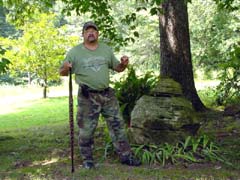
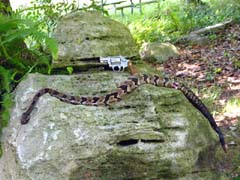

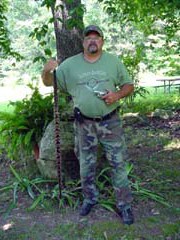
  

The basic ingredients: R-P .38 Special case,
4.3 grains W-W 231 powder, cut cardboard wad, 70 grains #9 hard shot, and
a .375 pure lead ball.
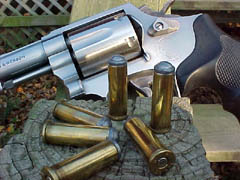
The finished product, ready to protect us
against them mean ol' rattlers!
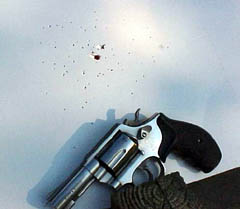
The result: a nice, tight #9 shot pattern with
a .357" hole in the center for emphasis.

Special thanks to Cousin Melvin for his help in
developing & testing the Snake Stopper.
|
![]()